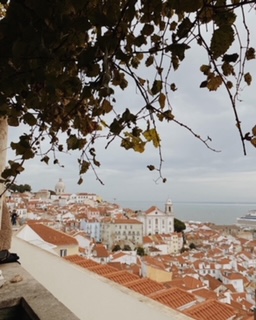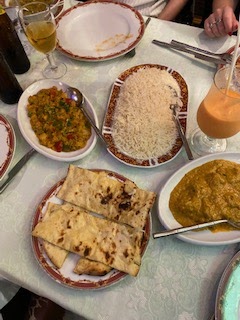When I first stepped foot off the plane and into Spain, I had no idea what to expect. Literally, my phone was dead, I didn’t look up directions to my apartment, and I had no plan. Everything worked itself out and after a self-made tour of the city, luggage in hand, I found my way. My goal with this blog is to be a one-stop shop for all the information I wish I had known before I left for the trip of a lifetime and encourage you to step out of your comfort zone as you embark on your study-abroad journey.
As you are considering Spain for which school, country, and program might be a good fit for you I am sure you have many questions such as cost, school load, transportation, social life, and many others. While I am sure each experience abroad will be different and unique if you are looking for advice and assurance from my experience, I have nothing but great things to say.
As for cost: Spain is one of the cheapest European countries to live in. If you end up choosing Comillas as your school, they partner with 5-6 housing sites and offer discount codes. I found my housing through Aluni.net which had a 20% discount for Comillas students. I ended up choosing a more expensive apartment that had a balcony and paid 560 (640 with utilities). There were plenty of apartments on Aluni’s site and others for around 350-500/month.
As for groceries, I never paid more than $30 on one grocery trip. A typical shopping trip for me included pasta, sauce, rice, chicken, bananas, strawberries, tomatoes, broccoli, onions, peppers, and avocados. This normally totaled $11. On restock weeks I would purchase instant coffee, bread, eggs, milk, cream, pesto, flour, butter, sugar, and ice cream. On restock weeks I would total 25-30. I was conservative with my grocery bill and stuck to the same few meals. I would say you should budget 20/week for groceries. As for eating out, tapas bars are a great place to get some cheap food. Even nicer restaurants normally don't go over $25 including a drink. I tried to limit myself to only going out to eat maybe 2-3 times a month with friends. I frequent coffee shops 5-6 times a week. A cappuccino and croissant normally came out to 3-5 depending on the cafe. For myself, I tried to stick to $11-15 at the grocery store and under $20 on eating out per week, and under $125/per month on food as a general rule of thumb. You definitely can go cheaper, or more expensive, depending on how your meal plan and what your priorities and budgets are.
The next cost to consider in your budget is how much you want to spend on traveling. I didn’t even really account for this in my original travel abroad budget, so I only visited some cities around Spain and Portugal. If you know you want to travel more, I would definitely add 1-2k extra to your overall budget. One amazing perk to doing your travel abroad in Madrid is there are some awesome travel and international organizations to follow on Instagram. SmartInsiders, CityLife, and Erasmus Madrid are three you should follow as soon as you know your plans. All three do excursion trips out of Madrid for great prices. I traveled with CityLife to Valencia and did several trips through SmartInsiders. The weekend trip to Valencia, including two nights hostel, breakfast, and transportation was $80. SmartInsiders does day trips to Segovia, Toledo, Cuenca, and many others for $25. A weekend trip will be $75-100, and they offer 3-5 day trips to nearby countries for $150-200. This can be a great option to go with a trusted group and not have to worry about your transportation and housing since they will take care of it all for you. If you are planning your own trips, RyanAir is a great cheap flight site, and Flixbus has some great options for closer travel. I used Flixbus to go to Lisbon and my roundtrip bus ticket was $20.
As for school life at Comillas, again I have to sing their praises. One of the first things after confirming your exchange is being added to a WhatsApp group led by their international student organization and all the other students exchanging in the same semester. They keep you up to date on any information you need and plan a very thorough welcome week full of social events. Once school begins, you have two weeks to add/drop classes. I can only speak to the Cantoblanco campus and the International relations/politics/history courses, but the teachers were all really helpful, the native students were kind and welcoming, and the workload was not too much. For my classes, each had three assignments: an individual essay, a group project, and a final exam; the exam being worth 50% of the overall grade. I enjoyed having only three assignments because I had the time during the semester to work on them thoroughly and was not overwhelmed on a weekly basis. Also, something different about school in Spain is that the exam period is almost a month long. Classes will end and it could be 1-3 weeks before your final exam. They take studying really seriously. I took all of my classes in Spanish and all of my professors were accommodating of my imperfect grammar.
Switching topics slightly, if you know you are going to be at the cantoblanco campus you might be debating about where to live or how the public transport works in Madrid. I will start by saying I 100% recommend living downtown. Chamberi, Sol, and Malasana are three areas I recommend. It will be better for social life and things to do if you live downtown. From Sol, it will be a 25-minute renfe train ride to the cantblanco campus. I lived in Chamberi, so I took the metro to Sol, and then Renfe to cantoblanco which I budgeted 1hr 10min for this trip. Madrid has three main forms of public transportation you can use with the purchase of the transport card: the metro, the city bus, and cercanias renfe (short-line trains). If you are on the ball with your planning, you can visit this site https://tarjetatransportepublico.crtm.es/CRTM-ABONOS/home.aspx and order your transport card so it is there when you arrive. You can have it mailed to city life and then pick it up from them. If you are like me and didn’t even bother to look into public transport until you arrive, you can buy a ten-ride pass for the bus/metro at any metro stop, and a separate ten-ride pass for renfe at any of the renfe stops. If you visit the city life office, they can help you schedule an appointment to get your official transport card at any time, or you can make an appointment at the same site linked above. I recommend getting your personal official card as soon as possible. For youth 18-26 it is $20 a month for unlimited use of the bus, metro, and renfe.
Now that I have gone over the technical parts of what studying abroad in Madrid looks like, I want to finish off with some of my personal favorite moments.
The first event I went to, and where I ended up meeting some of my closest friends, was the welcome picnic at Templo De Debod hosted by the international student organization Unity from Comillas. That park is probably the best sunset spot around. It overlooks the city and the royal palace. There are tons of street vendors and musicians, and it is the only public park where you can drink (responsibly of course). I spent the night sharing sangria and dancing with strangers and friends from all over the world.Over Halloween my roommates and I visited Lisbon and Sintra, Portugal. I have wanted to see the Palacio Nacional de Pena for years now and it did not disappoint. I adored Portugal
and highly recommend visiting!









No comments:
Post a Comment